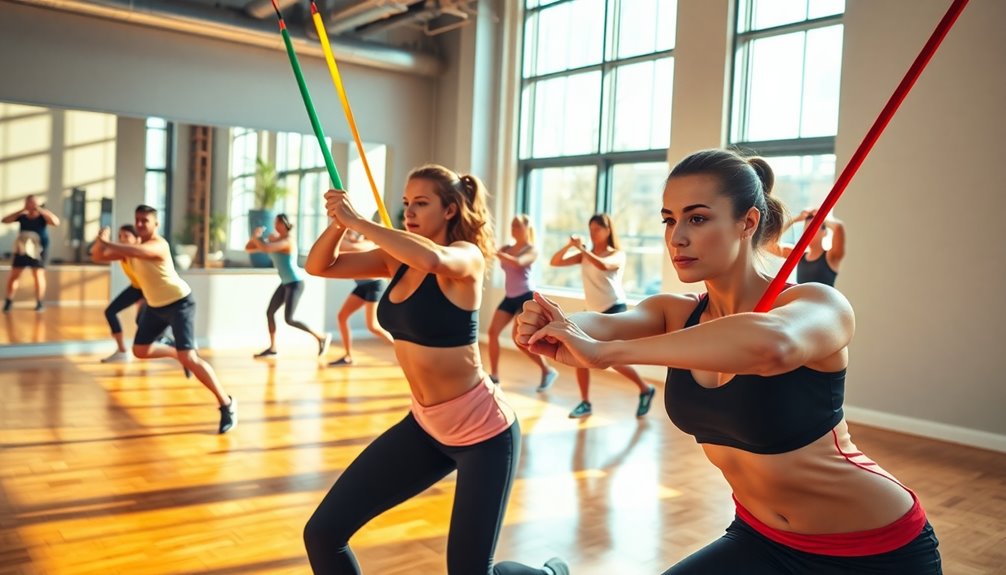Resistance band workouts are a fantastic way to achieve full-body training in just 20-30 minutes. These bands provide constant tension, enhancing muscle activation and improving both strength and endurance. You can easily incorporate upper body exercises like rows and curls, alongside lower body moves like squats and glute bridges. You can customize your routine with different bands, making it suitable for all fitness levels. Remember to warm up beforehand and cool down afterward to help prevent injuries. With varied exercises, you're set for an effective workout that keeps challenging you. You'll discover even more tips to elevate your training further!
Key Takeaways
- Resistance band workouts can efficiently engage multiple muscle groups, providing a full-body workout in just 20-30 minutes.
- Incorporate exercises like standing rows, squats, and glute bridges to target the upper and lower body effectively.
- Utilize bands of varying resistance levels to adjust intensity and ensure progressive overload for muscle growth.
- Include a warm-up and cool-down routine to enhance performance, flexibility, and recovery after workouts.
- Customize your circuit by mixing different resistance band exercises to keep workouts challenging and engaging.
Benefits of Resistance Band Training

Resistance band training offers a versatile way to enhance your fitness routine while providing a range of benefits that traditional weights can't match. One of the standout advantages is muscle activation. Resistance bands create constant tension throughout your movements, which means your muscles engage more fully compared to lifting free weights. This heightened muscle activation not only improves strength but also boosts endurance, giving you more bang for your workout buck.
Another key benefit is time efficiency. Let's face it; you've got a busy life, and spending hours in the gym isn't always feasible. Resistance bands allow for quick, effective workouts that can be done almost anywhere—your living room, a park, or even while traveling. You can perform a full-body workout in just 20 to 30 minutes, targeting all major muscle groups without the need for heavy equipment.
Additionally, bands come in various resistance levels, making them suitable for beginners and seasoned athletes alike. You can easily adjust the intensity of your workout by changing the band or altering your grip. This adaptability means you'll always feel challenged, helping you stay motivated and engaged. Furthermore, using mini bands can reduce joint pressure as they do not rely on gravity, making them a safe option for effective muscle toning.
Essential Equipment and Setup
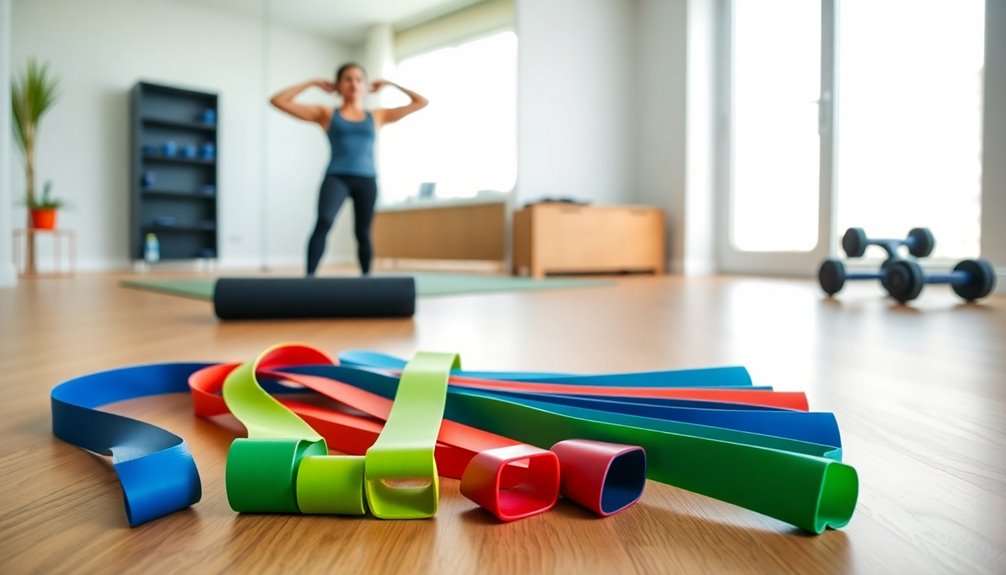
To kick off your resistance band training, you'll need a few essential pieces of equipment and a proper arrangement to maximize your workouts.
First, let's talk about resistance band selection. You'll find bands in various resistance levels, typically color-coded for easy identification. Start with a light to medium resistance band if you're new to strength training. As you progress, you can gradually switch to heavier bands to continue challenging yourself. Having a variety of bands on hand can keep your workouts fresh and exciting.
Next, it's important to establish proper anchoring techniques. This guarantees your bands stay securely in place during exercises, preventing any accidents. You can anchor your bands to sturdy objects like door frames, heavy furniture, or even through specific door anchors designed for resistance bands. Make sure that whatever you choose can withstand the force without moving or tipping over. Always double-check your setup before starting an exercise to maintain safety and prevent injury.
Lastly, consider using a yoga mat or a non-slip surface for added comfort and stability during your workouts. With the right equipment and arrangement, you'll feel confident and ready to tackle full-body exercises. Remember, you're not alone in this journey—many others are also discovering the benefits of resistance band training, so embrace the community spirit as you work towards your fitness goals! Additionally, incorporating resistance band workouts can help activate your dormant glutes, enhancing your overall performance and efficiency in exercises.
Warm-Up Exercises
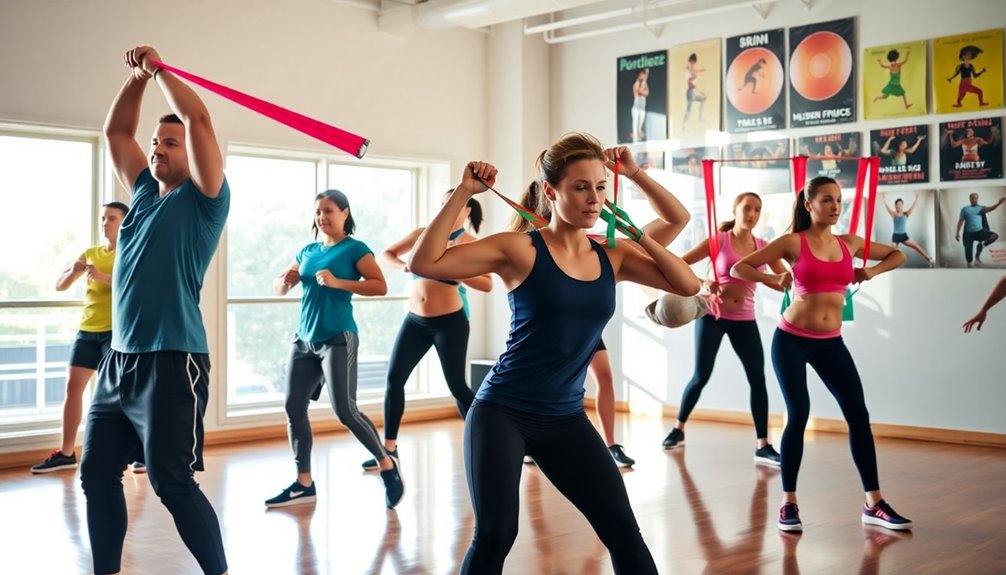
Once you've got your equipment set up, it's time to prepare your body for the workout ahead. A proper warm-up is essential for preventing injuries and enhancing your performance. You'll want to include dynamic movements that get your heart rate up and engage your muscles.
Start with a few minutes of light cardio—jogging in place or jumping jacks work great. This increases blood flow and warms up your entire body.
Following that, incorporate activation exercises to target specific muscle groups you'll be using during your resistance band workout. For instance, try glute bridges to activate your glutes or arm circles to get your shoulders ready.
Dynamic movements like leg swings and torso twists can also help improve your range of motion and flexibility. These movements should feel good and energizing, preparing your body for the challenges ahead. Additionally, focusing on spinal health during your warm-up can enhance your overall performance and reduce the risk of injury.
Remember, the goal is to feel connected to your body and the workout community around you.
You might even want to invite a friend to join you for this warm-up session. Sharing the experience not only enhances your motivation but also fosters a sense of belonging.
Upper Body Resistance Band Workouts

Upper Body Resistance Band Workouts
How can you effectively strengthen your upper body with resistance bands? Resistance bands are versatile tools that can help you achieve impressive results in shoulder sculpting and arm toning. They're perfect whether you're a beginner or a seasoned fitness enthusiast, and they can easily fit into your routine.
Start with the band anchored behind you at shoulder height. This allows you to perform a standing row, which targets your back and biceps. Grip the band with both hands, elbows bent, and pull towards your chest, squeezing your shoulder blades together. This move not only strengthens your upper body but also promotes good posture.
Next, try the overhead press. Stand on the band, grasp the handles, and lift your arms overhead while keeping your core engaged. This exercise is fantastic for shoulder sculpting, as it works your deltoids and triceps, giving you that defined look you desire.
For arm toning, consider the bicep curl. Stand on the band with your feet shoulder-width apart, hold the handles, and curl your arms toward your shoulders. This simple yet effective movement can help you achieve those beautiful, toned arms that make you feel confident. Incorporating exercises that support healthy nerves can enhance your overall workout performance and recovery.
Lower Body Resistance Band Workouts

While many focus on upper body workouts, incorporating resistance bands into your lower body routine can yield impressive results. Not only do these bands provide versatile options for glute activation, but they also enhance leg strengthening in a way that free weights sometimes can't match.
To get started, loop a resistance band around your thighs, just above your knees. This simple adjustment immediately engages your glutes and quads. Try performing squats or lateral walks; you'll feel the burn in no time!
For squats, lower your body as if sitting back into a chair while keeping your chest up. This motion will target your glutes and thighs effectively.
Another great exercise is the banded glute bridge. Lie on your back with your feet flat on the floor and your knees bent. Place the band over your hips and push through your heels to lift your hips toward the ceiling. Squeeze your glutes at the top for maximum activation.
If you're looking for variety, consider incorporating banded leg lifts. Stand tall and attach a band to your ankle. Move your leg outward against the band's resistance, keeping your core engaged. This exercise not only targets your outer thighs but also contributes to overall leg strengthening. Additionally, incorporating exercises targeting specific problem areas can lead to more effective workouts and improved fitness results.
Core Strengthening With Resistance Bands
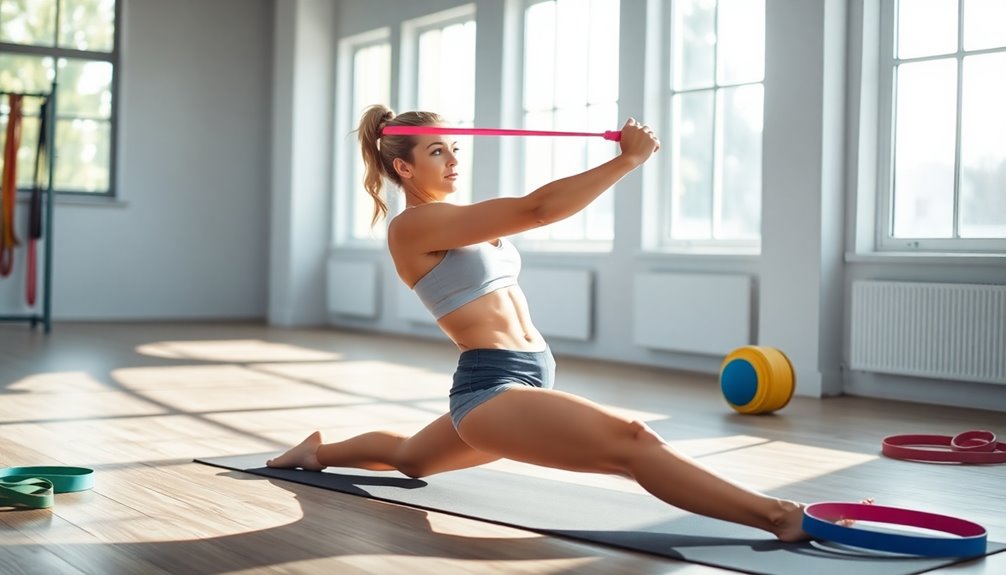
Core Strengthening With Resistance Bands
When you think about building core strength, resistance bands can play a pivotal role in your routine. They not only help in improving core engagement but also introduce stability challenges that make your workouts more effective. By incorporating resistance bands, you can target your abs, obliques, and lower back, all while keeping things fun and dynamic. Additionally, engaging in these exercises can contribute to lower blood pressure and overall cardiovascular health through mind/body exercises.
Here are some great exercises to get you started:
- Band Russian Twists: Sit on the floor with your legs bent, holding the band with both hands. Twist your torso side to side, feeling the core engage with each movement.
- Standing Oblique Crunch: Anchor the band below your feet, hold one end in your hand, and lift your knee toward your elbow. This adds a balance component while working your obliques.
- Plank with Band Row: Get into a plank position with the band anchored in front. As you row the band back towards you, your core will have to stabilize against the resistance.
- Seated Band Press: Sit with your legs extended, holding the band overhead. Press your arms forward while keeping tension on the band, engaging your core throughout.
These exercises not only enhance your core strength but also make your routine feel more inclusive and engaging. Plus, they can easily be modified for different fitness levels, so you and your friends can join in and support each other on your fitness journeys.
Full-Body Circuit Routine
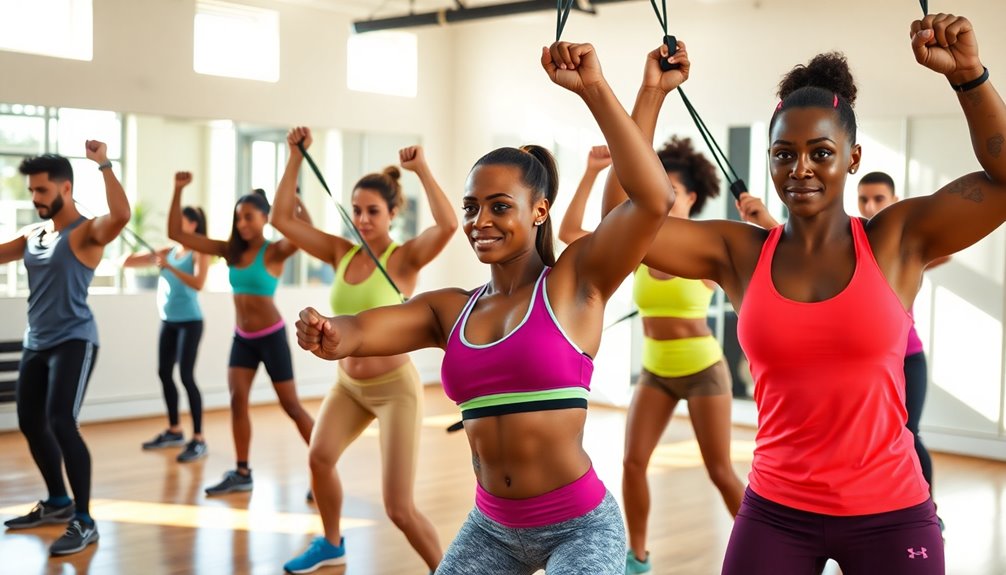
Maximizing your workout efficiency, a full-body circuit routine with resistance bands can transform your fitness regime. This approach not only saves you time but also guarantees you're engaging multiple muscle groups in a single session. Imagine completing a workout that activates your arms, legs, core, and back in less than an hour—sounds appealing, right?
In a full-body circuit, you'll perform a series of exercises back-to-back with minimal rest in between. This keeps your heart rate up, boosting calorie burn while enhancing muscle activation. You can easily customize your routine by mixing different exercises like squats, rows, and chest presses, all while using resistance bands to add that extra challenge.
What's great about resistance bands is their versatility. You can adjust the intensity by changing band thickness or the length of the band you're using. This adaptability makes it easy for anyone, regardless of fitness level, to join in on the fun.
To structure your time efficient circuits, aim for 30 seconds of work followed by 15 seconds of rest. Complete the circuit three to four times, and watch your strength and endurance improve. Not only will you feel accomplished after each session, but you'll also foster a sense of community if you invite friends to join in.
Incorporating regular exercise into your routine can also help manage underlying conditions like hypertension, which is crucial for overall wellness.
With just a few bands and a little creativity, you're well on your way to a full-body workout that fits seamlessly into your busy life!
Tips for Effective Resistance Training
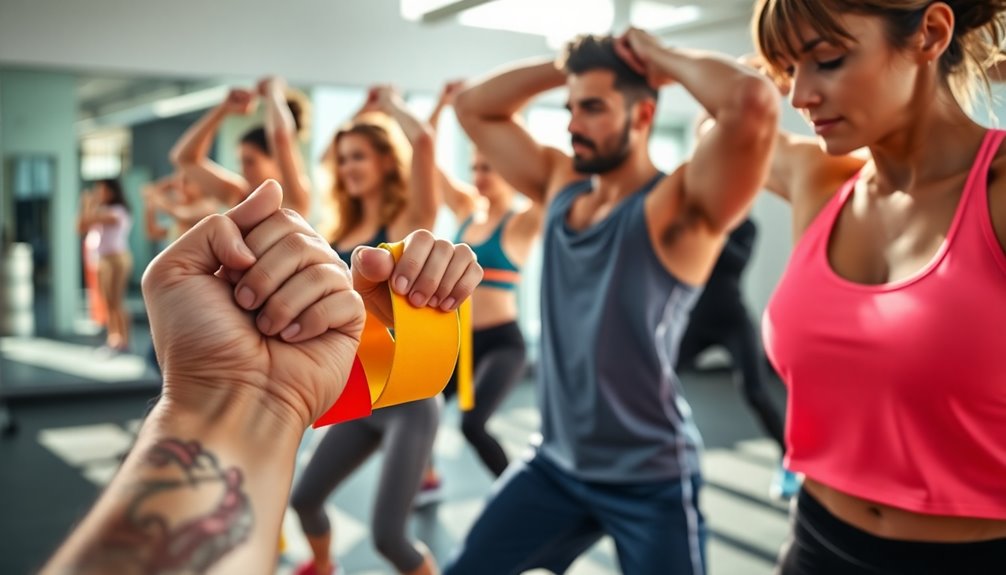
After you've established a full-body circuit routine with resistance bands, it's important to focus on how to get the most out of your training sessions. Here are some tips to optimize you're maximizing your efforts:
- Choose the Right Resistance Band: Resistance band selection can make a huge difference. Opt for bands that challenge you without compromising your ability to maintain proper form.
- Prioritize Proper Form: Always focus on technique over the number of repetitions. Proper form not only prevents injury but also ensures that you're effectively targeting the muscles you want to strengthen.
- Implement Progressive Overload: Gradually increase the resistance or the number of repetitions over time. This principle of progressive overload is crucial for continued muscle growth and strength gains.
- Track Your Workouts: Keep a journal or use an app to monitor your progress. Workout tracking helps you stay accountable and allows you to see how far you've come, motivating you to push harder.
Additionally, incorporating a plant-based diet can enhance your recovery and overall performance, as it promotes longevity and leads to a longer, healthier life.
Modifications for All Fitness Levels
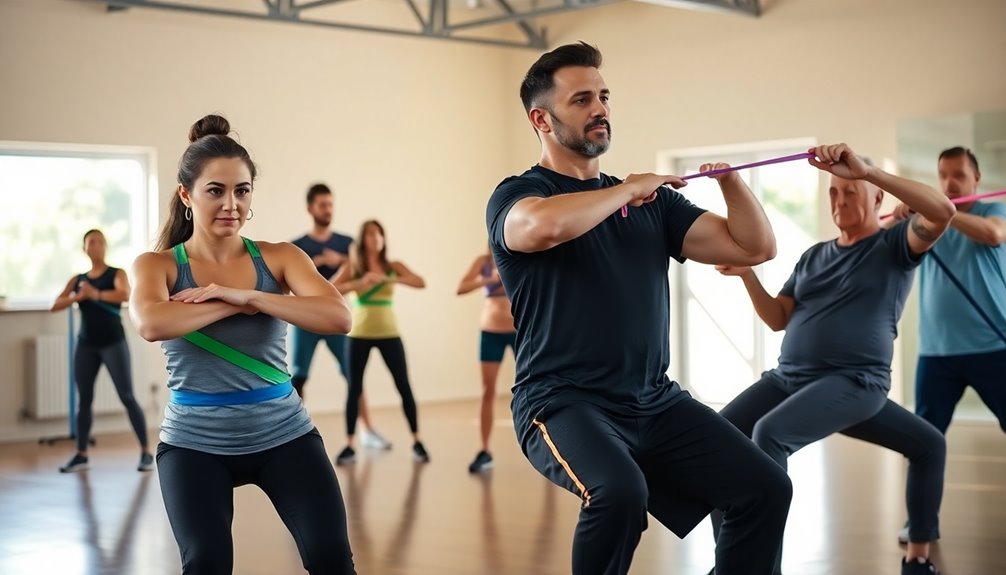
Modifications make resistance band workouts accessible for everyone, regardless of fitness level. Whether you're a beginner or a seasoned athlete, there's always a way to tailor exercises to fit your needs. Understanding progression options and scaling modifications is key to ensuring you stay challenged while also feeling comfortable during your workouts.
Here's a simple guide to help you identify some effective modifications for common resistance band exercises:
| Exercise | Modification | Progression Option |
|---|---|---|
| Bicep Curls | Use a lighter band or perform seated | Increase band resistance or stand on the band |
| Squats | Perform half squats or use a wall for support | Add a pulse at the bottom of the squat |
| Chest Press | Perform one arm at a time or reduce band length | Increase both arms or step away for more resistance |
By making these adjustments, you can find the right intensity for your body. As you grow stronger, you can gradually increase the challenge, ensuring your workouts remain effective and engaging. Remember, it's not about how much you can lift but how you can adapt and grow.
You belong to a community that values progress and participation. Everyone is on their own journey, and it's perfectly okay to modify exercises to meet your current fitness level. Embrace the process, and don't hesitate to experiment with different options until you find what works best for you!
Cool Down and Stretching Techniques
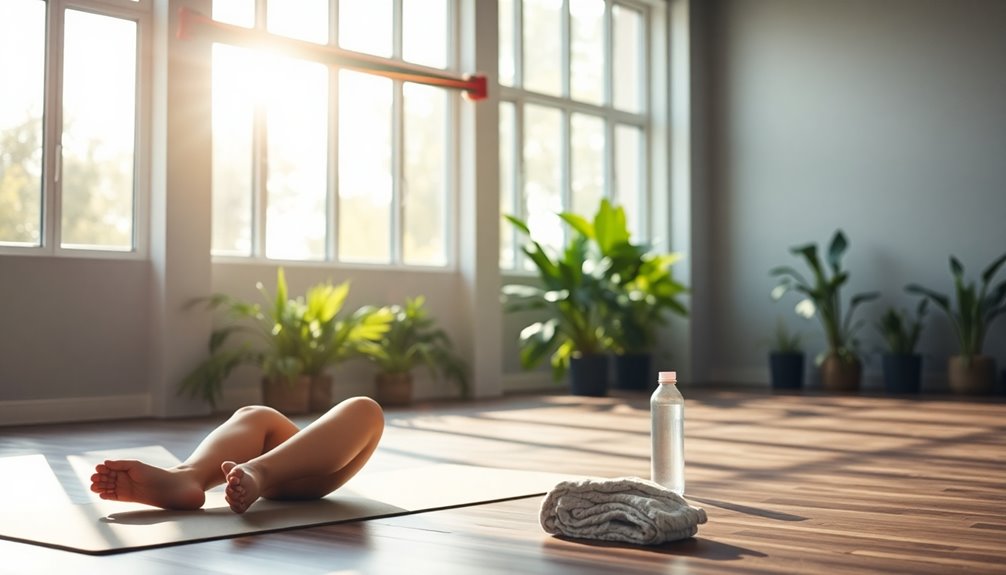
Cooling off and stretching after your resistance band workout is just as crucial as the exercises themselves. It aids your body in shifting back to a resting state, enhances flexibility, and reduces muscle soreness. You'll not only experience physical improvement but also mental well-being. Engaging in stretches after your workout cultivates a strong mind-body relationship, enriching your overall experience. Incorporating mindfulness meditation into your cooldown routine can further enhance your recovery and mental clarity.
Here are some effective methods to include in your cool down regimen:
- Gentle Forward Bend: Stand tall, then gradually lean forward, allowing your arms to hang towards the ground. This stretch eases tension in your back and hamstrings.
- Cat-Cow Pose: On all fours, alternate between arching your back (cat) and lowering it (cow). This sequence boosts spine flexibility and promotes relaxation.
- Seated Hamstring Extension: Sit with one leg stretched out and the other bent. Reach towards your toes, sensing the stretch in your hamstring. Take deep breaths to enhance your mindfulness practices.
- Child's Posture: Kneel and settle back on your heels, extending your arms forward. This position promotes deep relaxation and contemplation of your workout.
While cooling off, acknowledge the dedication you've shown. Embrace this period for unwinding and contemplation. By including these post-workout stretches, you'll improve your recovery and fortify your mind-body connection, preparing for your next workout session.
Frequently Asked Questions
How Often Should I Do Resistance Band Workouts?
To see the ideal results, aim for resistance band workouts about two to three times a week. This prime frequency allows your muscles to recover while reaping the benefits of increased strength and endurance.
As you progress, you can adjust the intensity levels to challenge yourself further. Listen to your body, and don't hesitate to mix things up to keep your workouts engaging and effective. Remember, consistency is key to achieving your fitness goals!
Can I Use Resistance Bands While Traveling?
Imagine rolling out a mat in a hotel room, ready to energize your day. You can definitely use resistance bands while traveling! They're lightweight and easy to pack, making them perfect resistance band alternatives.
Plus, you'll enjoy resistance band benefits like improved strength and flexibility, even in a cramped space. So, don't let travel disrupt your routine; just grab those bands and keep your fitness journey alive, wherever you go!
Are Resistance Bands Suitable for Seniors?
Absolutely, resistance bands are suitable for seniors! They offer numerous benefits, like improving strength and flexibility with senior modifications tailored to individual needs. Following safety precautions is crucial, such as starting slow and ensuring proper form.
You can easily adjust the intensity with progressions, so you'll feel comfortable as you grow stronger. Incorporating resistance bands into your routine can enhance your fitness journey while fostering a sense of belonging in a supportive community.
How Do I Choose the Right Resistance Band?
Choosing the right resistance band is like picking the perfect tool for a job. Start by considering the resistance band levels—light, medium, or heavy—based on your fitness goals and experience. Beginners often benefit from lighter bands, while experienced users might prefer heavier options.
Can Resistance Bands Replace Traditional Weight Training?
Can resistance bands replace traditional weight training? While they offer benefits like portability, versatility, and reduced joint strain, they do have limitations.
Resistance bands can be highly effective for strength training, but they mightn't provide the same intensity as free weights for advanced lifters.
You'll find that incorporating both methods can enhance your routine, allowing you to enjoy the best of both worlds while addressing any drawbacks of either training style.
Conclusion
Incorporating resistance band workouts into your routine can greatly enhance your strength, flexibility, and overall fitness. Did you know that studies show resistance training can boost your metabolism by up to 15%? This means you're not just building muscle; you're also increasing your body's calorie-burning potential even at rest. So grab those bands and start your journey toward a stronger, fitter you! Your body will thank you for it, and the results will speak for themselves.

